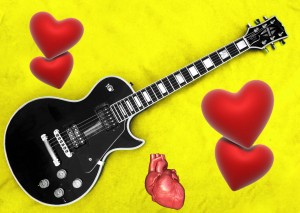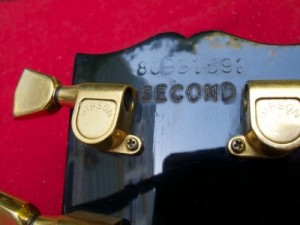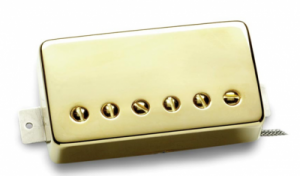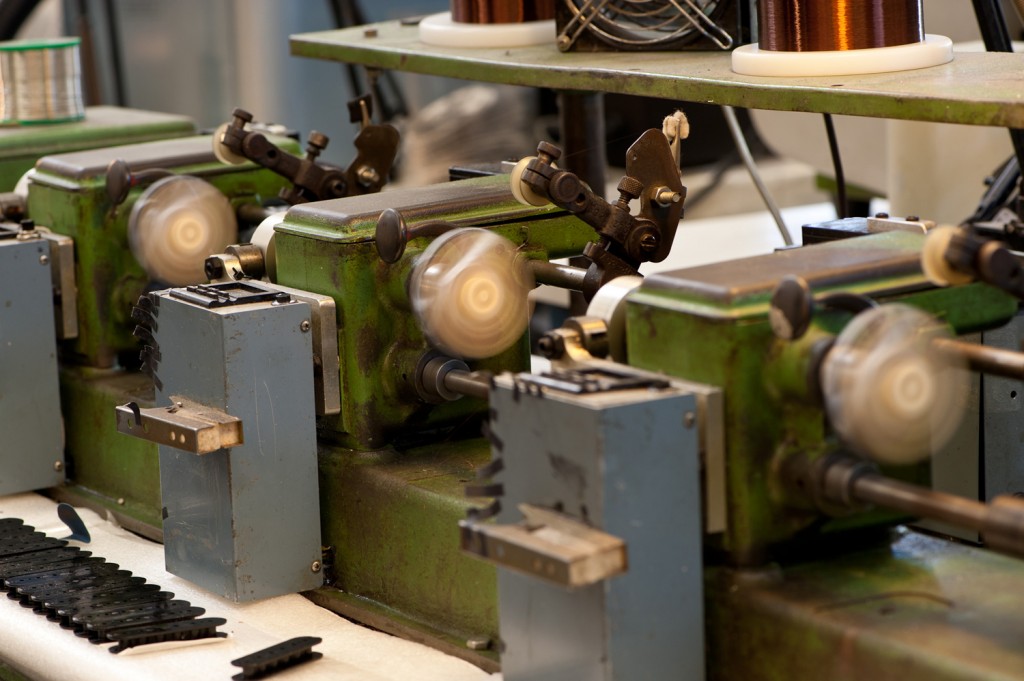Did you ever come across one of those magical guitars? The kind that just seems to cast everything you play in the best possible light? A guitar you never want to stop playing because it sounds so darn good?
Well, this story isn’t about that kind of guitar.
It’s about a singularly uninspiring 1981 Les Paul Custom I picked up a few years ago. Sonically and physically, the guitar delivered everything you think of when you think of your basic, post-vintage Paul, only less. So I call it the Less Paul.
When Gibson made it 30 years ago, they embossed the word “SECOND” on the back of the headstock. But the guitar has accumulated so much cosmetic damage over the years that it’s impossible to know which defect originally earned it this badge of shame.
I confess I’ve never been much of a Les Paul guy. If I was going to play through humbuckers, I’d go with a semi-acoustic, like my beloved mid-‘60s Gibson Trini Lopez, a weird and obscure model that used to sell for a fraction of the price of its better-known cousin, the ES-335. (That is, until Foo Fighter Dave Grohl and Noel Gallagher of Oasis started playing them, elevating their status from “weird and obscure” to “classic.”) Or I’d use some chambered Les Paul spin-off, like the Hamer 20th Anniversary model. To my ears, orthodox Les Pauls were always too heavy, too dense, too lacking in high-end animation.
Sure, I’d heard that original 1950s models had a lighter, zingier sound than later ones. They certainly sounded great in the hands of people like Jimmy Page and Jeff Beck. But come on—have you ever been privileged to spend significant quality time with a ’59 Les Paul? Me neither.
Anyway, I was doing a lot of work creating amp and effect models for Apple and other companies, and I wanted to have a basic Paul around for comparison purposes. It also came in handy when I started building analog stompboxes. I’d learned that if I could fine-tube an amp or pedal—be it real or virtual—so that it sounded pretty good on both a Strat bridge pickup and a Paul neck pickup, chances were it would sound pretty good with most guitars.
But the Less Paul was a mere tool, not a source of inspiration. Whenever a player would swing by my studio and try some guitars, I’d steer them toward cooler instruments. “Don’t bother with that one,” I’d say. “It’s a pig.” Yes, I’m harder on my guitars than most players, and that includes psychological abuse.
Fast forward to a few months ago, when I started speaking with the folks at Seymour Duncan about helping to create a tone-oriented blog for their website. It wasn’t till I’d accepted the amazing offer that I got around to disclosing my dirty little secret:
I had never installed a guitar pickup. I played guitars as they were, or paid someone else to do the dirty work.
Oh, that seems so long ago, after weeks spent trying out every pickup I could get my hands on. I was like a kid in a candy store, except kids don’t usually get paid to take candy. Ah, life can be hard sometimes.
(I’ll discuss my virgin install in a future post, but for now, suffice it to say that installing replacement pickups is shockingly easy, and it gets even easier with practice. I’m planning several step-by-step tutorials aimed towards those who have avoided the process due to fear, laziness, impatience, clumsiness, and lack of workbench skills. In other words, people like me!)
Anyway, back to the Less Paul. It was no longer a pig—it was a guinea pig!
Deciding what to install first wasn’t easy. (See previous “kid/candy store” comparison.) But after visiting Seymour Duncan HQ in Santa Barbara, California, I decided to go with a pair of Seth Lover pickups, extremely faithful replicas of a vintage P.A.F.s, the original mid-’50s humbuckers. They’re named for the man who invented the humbucker for Gibson in 1955. He was a mentor to Seymour W. Duncan, and the two were close friends until Lover’s death in 1997. When the Seth Lover model was released in 1994, Seymour worked from Seth’s original notes. And as if that weren’t vintage enough, these pickups are made on an historic Leesona winding machine that once resided at the old Gibson factory in Kalamazoo, Michigan.
It’s worth noting that this model is not some fancy-pants Custom Shop pickup, but a regular production model. In other words, it’s not very expensive.
Seymour’s office is just a few feet from the production floor, so I poked my head in to ask about the Seth Lover Model. Seymour’s lair is an amazing place, filled to bursting with the antique tools and collectibles he loves. Metal-stamp presses. Locksmith equipment. Native American arrowheads. A stack of ancient fire helmets. And snapshots of Seymour with seemingly every famous guitarist of the last 40 years.
Seymour explained how the idea was to create a P.A.F.-style humbucker that would sound just like one off 1957 factory floor, as opposed to the Antiquity humbucker, which was designed to sound and like a similar pickup after decades of wear and tear.
Given my tendency to avoid humbuckers in heavy-bodied guitars, I was also tempted by a pair of Seymour Duncan Phat Cats. These are replicas of Gibson P-90s, a pleasantly rough-edged single-coil pickup that predates the P.A.F., but reconfigured to fit a humbucker-sized cavity. But I was curious whether anything interesting would happen if I mated these ’50s-style pickups with an ’80s axe. Would a May/December romance blossom? Or would I just have a pig with pretty new jewelry?
I’m recording the audio evidence right now. Check back in a few days for the results!
In the meantime: Anyone have any magic makeover stories? Did you ever fall for a guitar you used to hate?












I have an early 70’s Les Paul Custom. Last year I put a JB in the Bridge and a Jazz in the neck. I also coil split. I sounds great. And now I get a few more sounds to booth. Wish I could afford a 56 Gold top. I love Les Pauls!!!
Hey Keith — thanks for chiming in!
Funny story: A producer friend of mine left the country for a couple of years, and loaned me his mid-’50s goldtop! It was a cosmetic disaster, but the body, neck, wiring, and P-90 pickups were all original. It sounded great—but to be honest, not necessarily greater than any number of stout guitars with great pickups. If I had to take a blind listening test, I’d probably favor my Hamer 20th Anniversary with SD pickups over this particular goldtop.
Obviously, there’s a lot of variation from instrument to instrument with those old guitars, and maybe this just wasn’t one of the great ones. On the other hand, it’s real easy to fetishize the old instruments when some new ones sound—or can be made to sound—just as good.
Nevertheless, I was quite sad to give it back.
I read a few posts here, and I wanted to let you know that I’m looking forward to reading more of what you had to say. I found this quite interesting. I remember my first pickup change – I put a set of P-Rails in my PRS copy. Even through the crappy 15W practice amp I had at the time, I noticed a huge difference. I bet part of it was the fact that I spent hours trying to wire the darned thing up – push pulls were tricky back when I was barely 16. Now that I have much better gear, I can appreciate the differences even more. Duncans rock!
Hey Joe don’t feel bad about your dirty little secret, Most people get a little stressed at the thought of heating up those factory solder joints. The first time I did I was a nervous wreck! I quickly learned it’s not a one shot deal, you don’t have to get it right the first time it’s solder just heat it up and start over. As for your Less Paul, After hearing it last weekend I can tell you it’s the sweetest sounding pig I have ever heard! ;^)
Two quick stories:
I was playing in a classic rock cover band in Grad school (1993?), and i needed a backup guitar. I got an Epi classic and plugged it into my gear, and it wasn’t sonically happening. Felt good, and acoustically sounded ok, but wasn’t happening through my gear. I decided to try some Duncans, and got a Pearly Gates neck, and Custom Custom bridge (after speaking with MJ at Duncan I suspect). We were playing ZZ Top, Clapton, Allmans, Zepplin, etc…Man, when I got that guitar back, it smoked my #1 LP (1979 with T-Tops).
It became very apparent that the bridge pickup was old and tired. I set out to learn how to replace these things myself. I finally settled on a Distortion for the bridge. BAM – there is the sound I was looking for.
Now, I’m a hack with an iron, which is ok because I’m a hack with a guitar too. But really, it was pretty darn easy to do. I can’t imagine being stuck with stock pickups. I think they are maybe 70-80% of the sound of the instrument.
That was before YouTube, and Seymour’s how to change pups video and all of that. I’m still waiting to do my first magnet swap though. I guess that will be covered in “Can you learn to love a pickup you hate”
Ooh, I’ve never tried a magnet transplant. If you do it, please record some before-and-after tracks.
Stick JB jrs in just about any Strat/Legacy and start your engines – I’ve been using a 200 G&L Legacy with JB jrs, push/pull coil tap and bridge/neck blender pot- Toney and very versatile!
I’m gonna try that. I’ve never played a JB Junior, but I snagged one from the SD guys. 🙂
I’ve got a ’96 Les Paul Classic Premium Plus with the stock ceramic 500T and 496R humbuckers; everybody and their accordion-mauling Auntie bags on those pickups across the internet, but I found that lowering the pickups- primarily on the bass-side- while approximately equally raising the pole-pieces under the wound, bass-side strings and lowering the pole-pieces under the plain treble-strings, gives them a much more airy, detailed, dynamic sound with more sparkle, swirl and “low keys on a piano” stringiness on the wound-strings, and a fatter, rounder, fuller, warmer tone on the plain-strings. Some time must be spent finding the “sweet spot” height for both the bass and treble sides, as well as balancing the output of the strings and the levels of the two pickups, but it’s worth the effort! A bonus- the middle/”both pickups on” selector-setting is much improved, sounding extra sweet, clucky and twangy!
Pickups can make or break a guitar. I thought my 58 reissue Telecaster was a pig until I put some Seymour Duncan pickups in it. Now it actually sounds like a Telecaster!